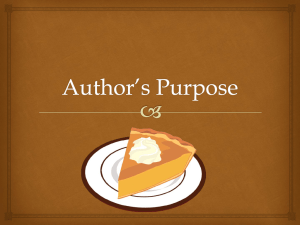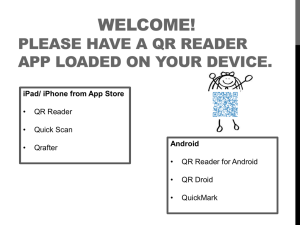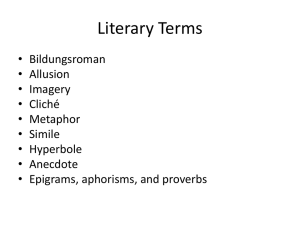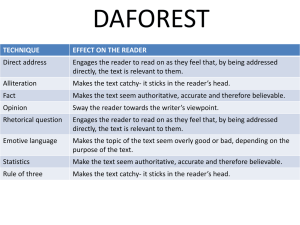Figurative Language
advertisement
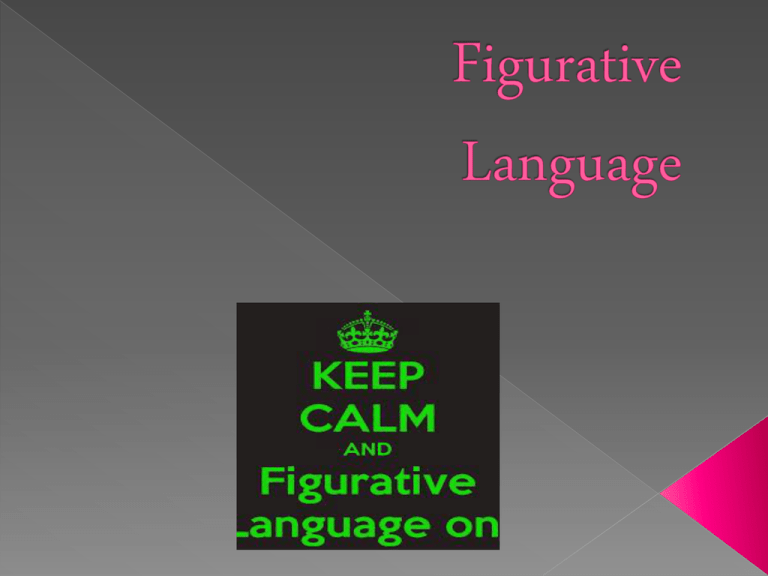
Definition › A comparison of two unlike things using the words like or as. Examples: › His feet were as big as boats. › She dances like a princess. Purpose › Makes it easier for a reader to understand the subject matter by comparing it to something else. Definition › A comparison of two unlike things describing one as if it were the other. › Does not use like or as. Examples: › Her hair is silk. › She is a graceful swan. Purpose › Makes it easier for a reader to understand the subject matter by comparing it to something else. For each example below, identify whether it is a simile or metaphor. Write “S” next to the Similes and “M” next to the metaphors. 1. The assignment was a breeze. 2. Her voice is music to his ears. 3. Our soldiers are as brave as lions. 4. Jim was boiling mad. 5. Her cheeks are red like a rose. For each example below, identify whether it is a simile or metaphor. Write “S” next to the Similes and “M” next to the metaphors. 1. The assignment was a breeze. (M) 2. Her voice is music to his ears. (M) 3. Our soldiers are as brave as lions. (S) 4. Jim was boiling mad. (M) 5. Her cheeks are red like a rose. (S) Definition › An exaggeration Examples: › My date last night was the most beautiful girl in the world. › My backpack weighs a ton! › I told you to clean your room a million times! Purpose › To make feelings seem more intense. › To emphasize a point for an amusing effect. As a group, come up with one hyperbole about homework. Definition › Repeated sounds occurring at the beginning of words › This should be used intentionally, not coincidentally Examples: › But a better butter makes a batter better. › Circe sat near the silent sea. Purpose › Creates a musical effect in the text that enhances the pleasure of reading. Write two sentences that use alliteration. › One sentence must use your name. › One sentence must use an animal. Definition › Human characteristics are given to nonhuman things. Examples: › The leaves danced in the wind. › The mountain held the clouds on its shoulders. Purpose › To bring inanimate things to life, so that their nature and actions are understood in a better way. 1. Create one example of personification about a computer. 2. Create one example of personification using a tree. Definition › An expression that means something other than its actual words. › You don’t take the words literally. › It doesn’t quite mean what it says Examples: › It’s raining cats and dogs. = It’s raining really hard › I heard it straight from the horse’s mouth. = › Sally got up on the wrong side of the bed! = Purpose • Convey complex ideas in a few words • Ensure the understanding of a listener Identify one example of an idiom and explain what it means literally. Definition: › An overused expression. Examples: › “Everything happens for a reason.” › “Love conquers all.” • Purpose • Convey complex ideas in a few words • Ensure the understanding of a listener 1. Think of one cliché involving money 2. Think of one cliché involving love/relationships 3. Think of one cliché involving looks/beauty • • • An idiom CAN be a cliché, but not necessarily. Some idioms have been used so much that they have become cliché. Not ALL clichés are idioms, and not all idioms are cliché. Clichés that ARE idioms • Think outside the box • See the glass half half full • Love is blind • Fall head over heels Clichés that ARE NOT idioms • Money doesn’t grow on trees • Only time will tell • Lost track of time time Idioms that ARE NOT cliché • Good riddance • Play our cards right • Every cloud has its its silver lining. Definition: › A brief reference to a person, place, or event of historical, cultural, literary, or political significance. › Does not describe in detail the person or thing to which it refers. › The writer expects the reader to possess enough knowledge to spot the allusion and grasp its importance. › Often explained in the foot notes. Examples: › Don’t act like a Romeo in front of her (Allusion to “Romeo and Juliet”) = don’t act so romantic › I think your nose is growing (allusion to “Pinocchio”) = you are lying. • Purpose • Enables a writer to simplify complex ideas and emotions. Complete the chart below by explaining a situation in which the allusion would be used. Ex: 1 2 Allusion Situation “May the force be with you” “He is like the Hulk.” “Don’t be a Scrooge” When a teacher passes out a test to students. Definition: › Language that appeals to a reader’s sense of sight, hearing, smell, taste, or touch. › Helps a reader visualize Examples: › “The lake was icy blue. The only sound that could be heard was the chirping of distant birds. The air was cool and crisp on my skin and I could see my breath in the morning air.” • Purpose : • allows an author to express thoughts more vividly or to bring out emotions in readers Work with your group to describe the classroom using your five senses Definition › An expression in which two contradictory words appear side by side › Often, at least one word’s meaning cannot be taken literally. Examples: › Jumbo Shrimp › Working Vacation › Small Crowd • Purpose • Create an ironic sense of humor • Emphasize certain qualities or ideas • Confuse the reader With your group, explain how each of these are examples of oxymorons. 1. Plastic glasses 2. Minor crisis 3. Unbiased Opinion Then-write two of your own oxymorons Definition › A statement that seems to contradict itself, but may be true. Examples: › “No one goes to that restaurant because it is overcrowded.” › “Don’t go near the water ‘til you have learned how to swim.” Purpose • • • • attracts the reader’s attention and gives emphasis creates an unusual thought or visual image with words conveys a tone of irony Explain how each of the each of the following represents a paradox: 1. The man who wrote such a stupid sentence cannot write at all 2. “Whatever you do will be insignificant, but it is very important that you do it.” –Gandhi Oxymoron Paradox • A statement • Seen as a thought or logic game Both • Two words Contradictory • Example: (seem like o Awfully opposites) good • Example: o Alone o “This statement is together false.” o You have to be cruel to be kind. Definition › A humorous play on words which suggests multiple meanings Examples: “Where do pancakes live? In a flat!” “I used to be a baker but I didn’t make enough dough.” “Seven days without pizza makes one weak.” • Purpose amusement reinforce meaning With your group, explain how the third example is a pun. -“Where do pancakes live? In a flat!” -“I used to be a baker, but I didn’t make enough dough.” -“Seven days without pizza makes one weak.” Write your own pun! Definition: › Repeated vowel sounds within words. › The author does this intentionally, not on accident. Examples: › Some ship in distress that cannot live. › Wear it here and there and everywhere. • Purpose • Improves the rhythm and flow of a poem • Forces the reader to pay attention to certain words • Engages a reader’s attention Write two examples of assonance. One of the two must not rhyme! Definition: › Repetition of consonant sounds within or at the end of words › The author does this intentionally, not on accident. Examples: › “But the father never answered a word. › “We passed the last tree.” • Purpose • • • Improves the rhythm and flow of a poem Forces the reader to pay attention to certain words Engages a reader’s attention Write two sentences that use consonance. One may not rhyme! For each example below, identify whether it is a simile or metaphor. Write “A” next to the example of assonance and “C” next to the example of consonance. 1. We light the fire on the mountain. 2. I feel depressed and restless. 3. The ship has sailed to the far off shores. 4. The engineer held the steering wheel. 5. And yet we knew that gentle clock meant nought. For each example below, identify whether it is a simile or metaphor. Write “A” next to the example of assonance and “C” next to the example of consonance. 1. We light the fire on the mountain. (A) 2. I feel depressed and restless. (C & A) 3. The ship has sailed to the far off shores. (C) 4. The engineer held the steering wheel. (C & A) 5. And yet we knew that gentle clock meant nought. (C) Definition: › An idiomatic expression which replaces words and phrases considered to be harsh or impolite. › Eu = Good Examples: › “Kick the bucket” is a euphemism for death. › “Downsizing” is a euphemism for firing someone. • Purpose • To make a harsh or impolite word or phrase sound more polite or proper. Identify a euphemism for “going to the bathroom.” Definition: › A question asked just for effect or to emphasize a point when no real answer is expected. › May have an obvious answer. Examples: › “To be or not to be?” › “It’s too hot today, isn’t it?” • Purpose • Often used in persuasive speeches to emphasize a point. Identify another example (besides a persuasive speech) where someone would use a rhetorical question. Think about the purpose – to emphasize a point. Who would likely use this and

